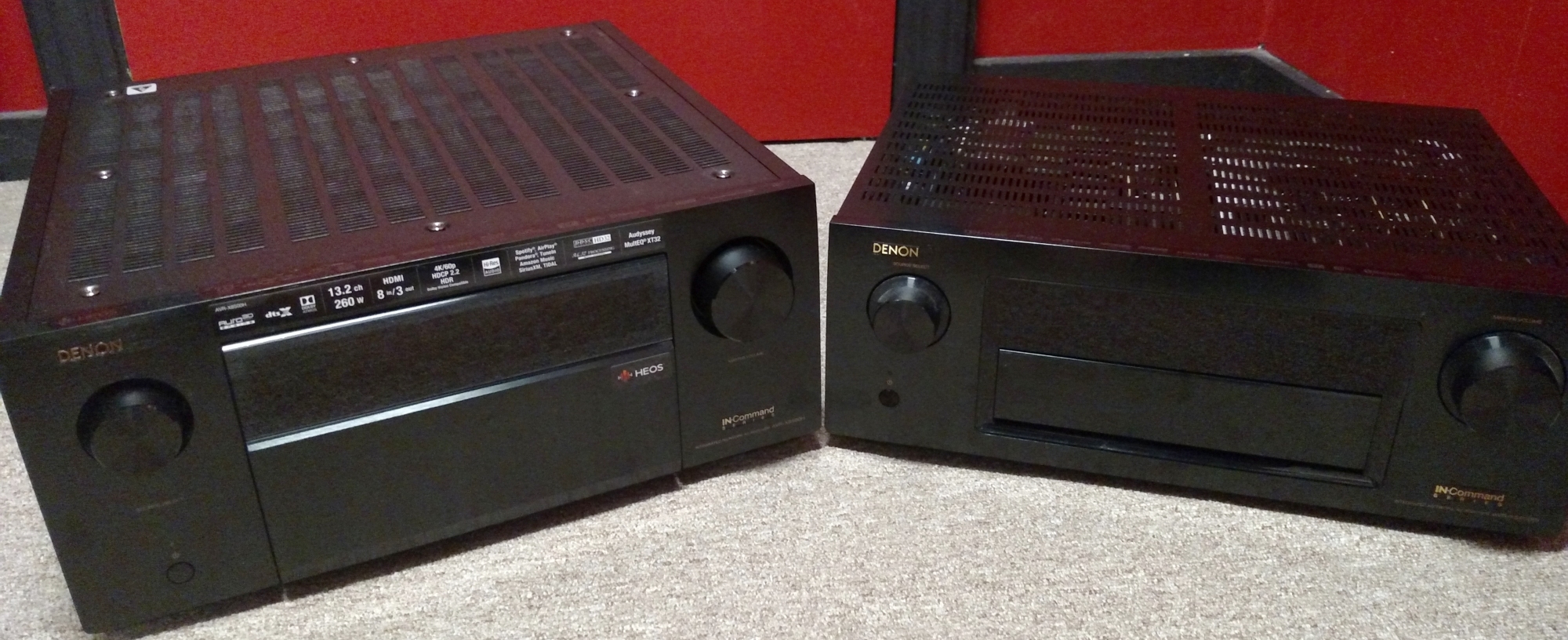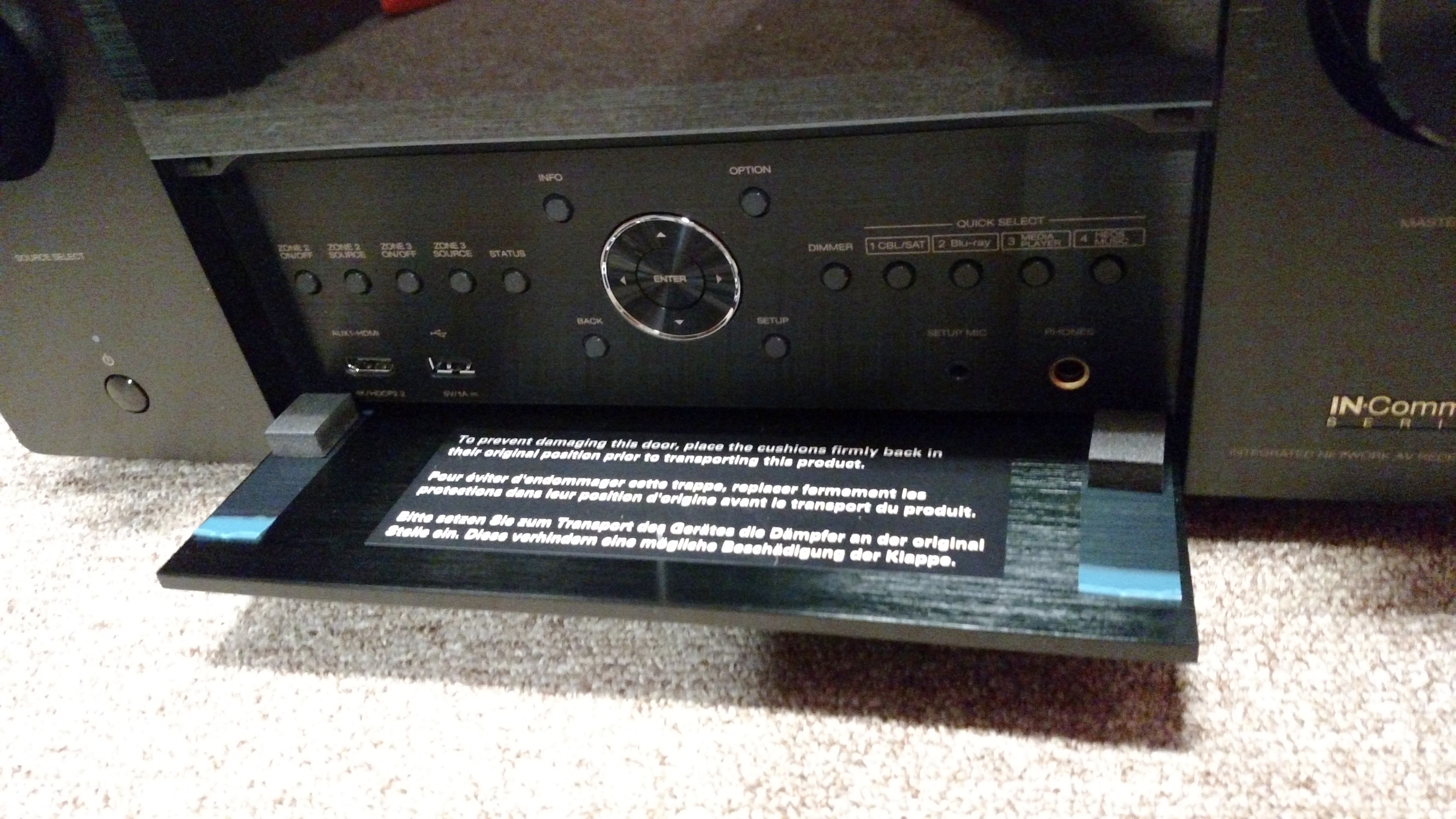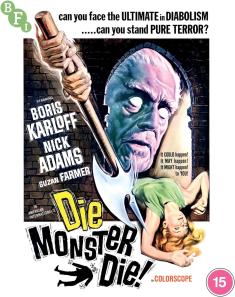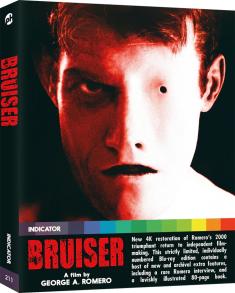Denon AVR-X8500H Flagship A/V Receiver
Overview -Overview - Denon's top-of-the-line flagship model for 2018, the AVR-X8500H is the first mass-market A/V receiver to offer 13 channels of decoding. That makes it possible to listen to Dolby Atmos or DTS:X soundtracks in either 9.1.4 or 7.1.6 configurations. The unit also has almost every current bell and whistle you could possibly want in a receiver (and a bunch you'll probably never use). In terms of quality and performance, it's nearly impossible not to recommend. Be warned, however, that all those features come with a hefty price tag of $3,999.00. If that doesn't scare you off, it's definitely HIGHLY RECOMMENDED.
INTRO
Unlike the majority of its receivers, which are replaced with new models every year, Denon only refreshes its flagship products every two to three years. The company's last flagship receiver was the AVR-X7200WA, released in early 2015. In most respects, the X7200WA had a feature set (enhanced over time with firmware updates) that still leaves little room for improvement even today. I imagine that most owners of that model are still very happy with it. However, like all other mass-market receivers up to now, the X7200WA was limited to 11 channels of decoding, topping out its Dolby Atmos and DTS:X processing at 7.1.4. Further, it also only had 9 power amplifiers built-in, requiring the addition of a separate outboard 2-channel amp to get the full benefit of all 11 speaker positions.
In comparison, the X8500H offers up to 13 channels of processing and actually has 13 built-in amps to take full advantage of the Atmos and DTS:X formats without need for external amplification. The cost of that difference is an extra $1,000 on the MSRP. Not only do you get what you pay for, you have to pay for what you get.
Denon's next model down this year, the $2,199 AVR-X6400H, is an 11-channel receiver with 11 amps. In convenience and price, that unit is arguably superior to the prior flagship. However, the only way to get 13-channel processing is to go all the way to the top of the current line.
At 51.6 lbs, the AVR-X8500H is a heavy beast. It also dwarfs my prior receiver, the 2014 Denon AVR-X5200W, in both height and depth.
The rear panel provides a comprehensive bevy of connection types, including 7 HDMI inputs. This should cover the needs of most users, aside perhaps from those still clinging to analog sources with S-video, and you're unlikely to find too many modern electronics that still support that anymore.
Note that, although terminals are available for 15 possible speaker positions, only 13 of those channels can be active at any one time.
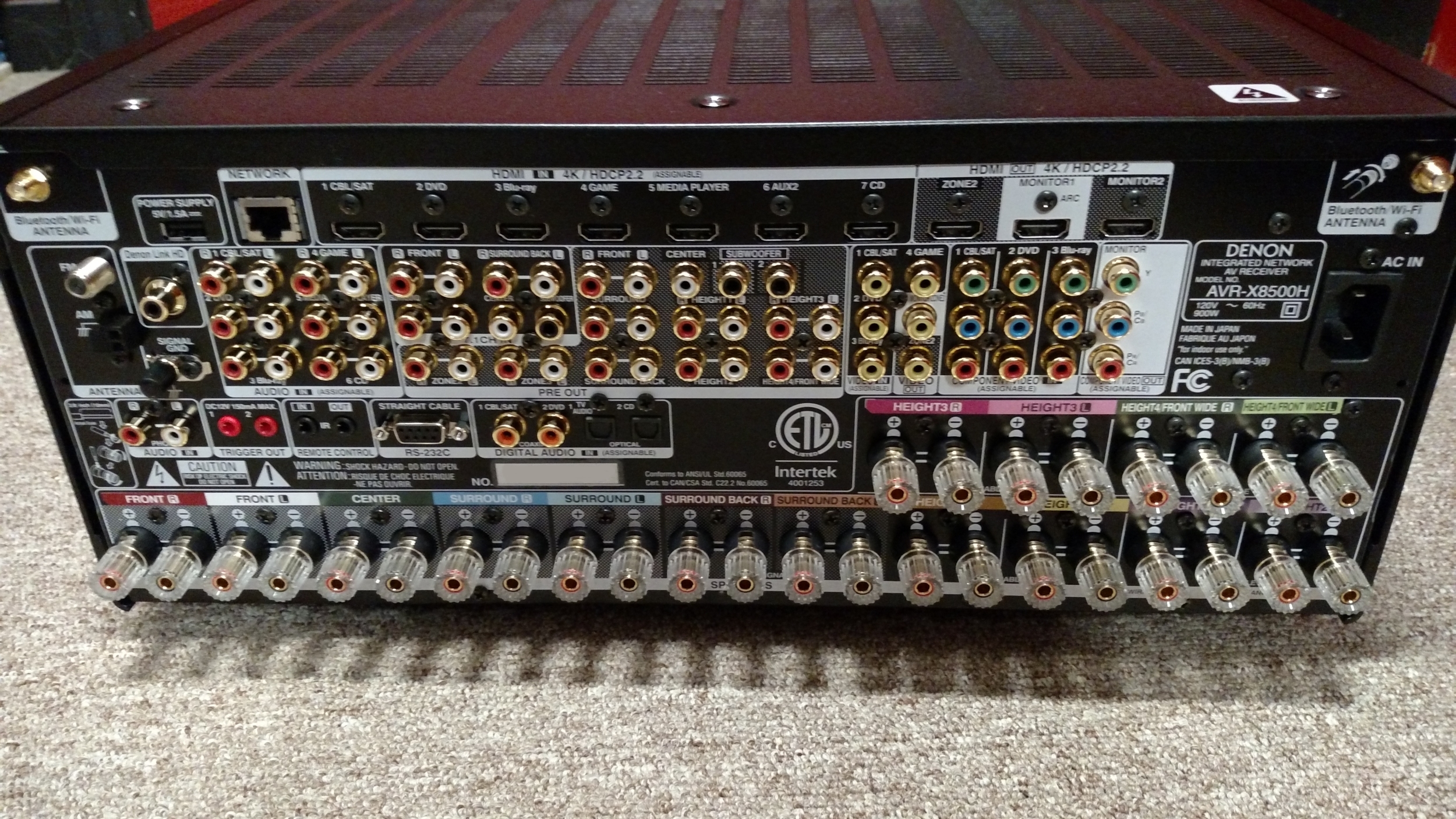
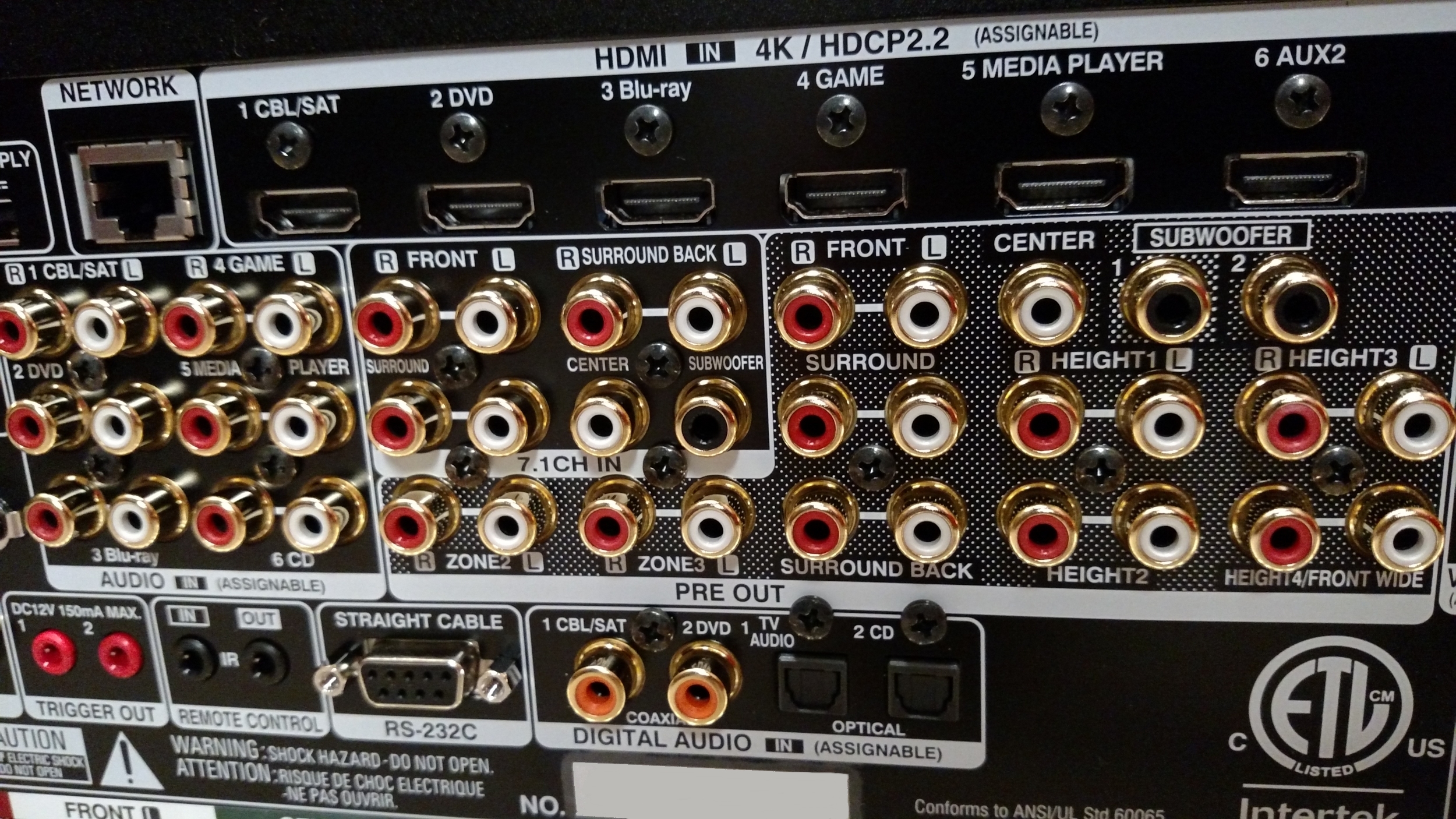
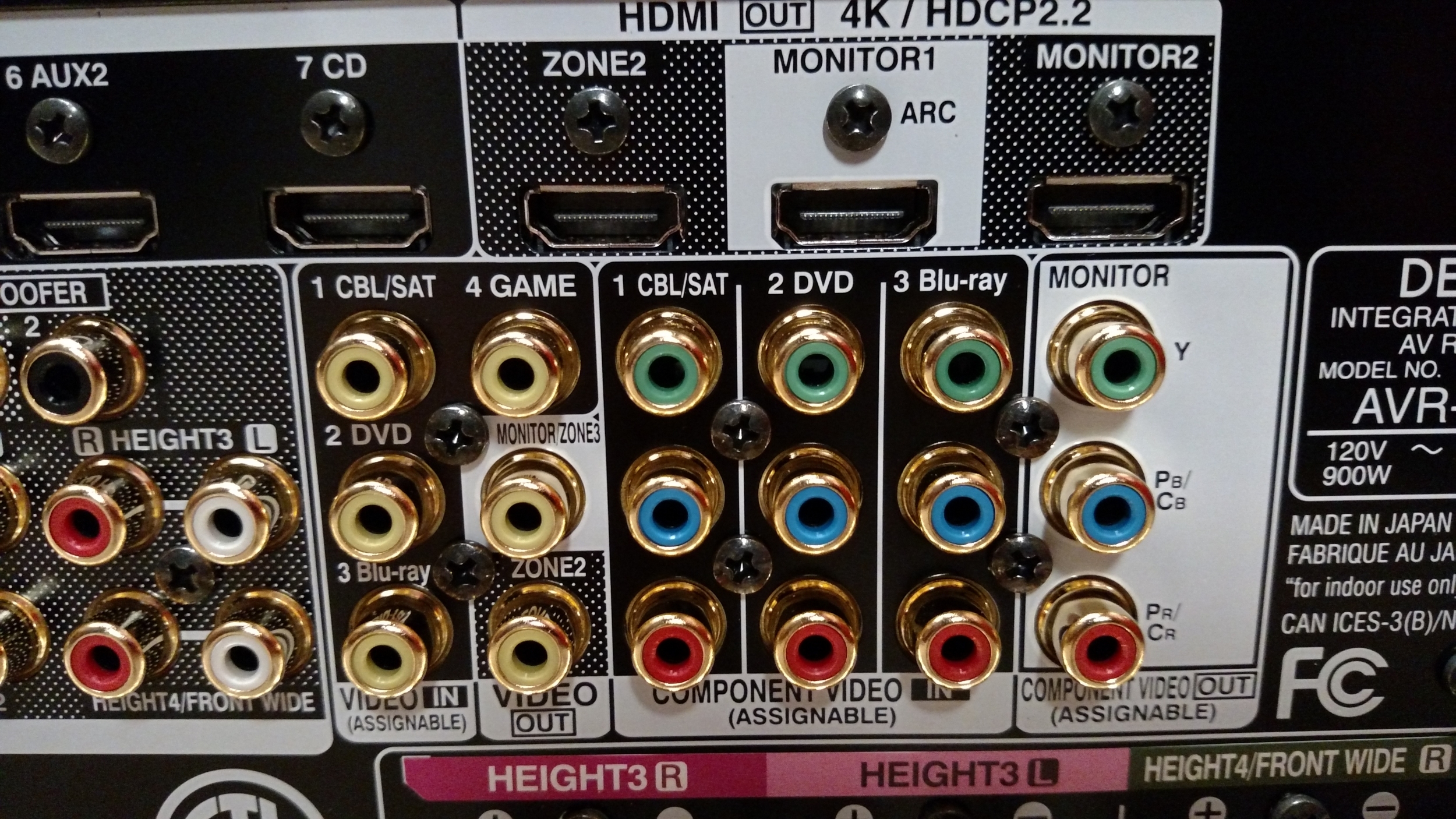
Beneath the flip-down front panel is an additional auxiliary HDMI input, as well as a USB input. Unlike my prior Denon receiver, the X8500H does not have any analog stereo inputs on the front panel. I'm sure most people won't be troubled by this absence, but I found an analog connection there very useful when running Room EQ Wizard calibration software from my laptop (which lacks an HDMI output). Now I need to run my cables around to the back panel, which is a minor inconvenience.
Per the manufacturer, the amplifiers inside the X8500H are rated at 150 Watts per channel at 8 ohm with two channels driven, the same as the X7200WA. Of course, that number goes down when you use a surround configuration with more than two speakers, and receiver makers rarely publish the numbers for all-channels driven. Since the X8500H has four more amplifiers than the X7200WA, you should expect the net result to be less powerful when all channels are working together. If you're really concerned about this, you can add external amplification to take over for some of the channels. That said, it's exceedingly rare for a movie soundtrack to drive all channels equally at the same time in any given scene, and rarer still for any of those channels to demand anything near 150 Watts of power. Realistically, the X8500H should be plenty powerful, if not overkill, for almost any application, save for someone who has quite inefficient speakers and a very large room to fill with sound.
LUCKY 13
One of the major benefits of an object-based sound format like Dolby Atmos is its scalability. No longer are sounds locked to specific channels or speaker positions. In theory, as you add more speakers, sound objects will map to their new locations and travel discretely through them based on where each object is supposed to be in the room. The theatrical version of Atmos allows for up to 64 speakers. The home version is more restrictive than that, but the format spec can still support as many as 24.1.10 speakers. (That's 24 speakers on the ground and 10 overhead, plus an LFE channel.)
Yet, until now, A/V receivers maxed out at decoding 7.1.4 channels. Only pricy boutique processors such as the Datasat RS20i ($23,170) or Trinnov Altitude 32 ($37,000!) have been able to decode more than 11 channels of sound. (And both of those are just pre-pros; you still have to buy amplifiers for every single channel separately.) To be fair, both of these units will still decode more channels (16 and 32, respectively) than the AVR-X8500H. Still, Denon's $4,000 asking price seems positively reasonable next to those.
The 13-channel decoding in the AVR-X8500H can be configured in either 9.1.4 or 7.1.6 layouts. The 9.1.4 option returns use of Front Wide speakers, which Denon had stopped supporting for a couple years to some owners' dismay. Be advised that, in Dolby Atmos, only sounds specifically encoded as objects will pass through the Front Wide channels, and the Dolby Surround Upmixer ignores them altogether. DTS:X and the DTS Neural:X up-mixer may put those speakers to more use.
If Front Wides are not of interest to you, the two additional channels can be used for height speakers instead. Previous mass-market receivers were limited to four height channels of sound, the most typical arrangement for which was Top Front and Top Rear designations. In most rooms, that should be enough to provide strong height effects with separation and directionality. When an airplane or helicopter is supposed to fly overhead, you can hear it move from the front to the back of the room or vice versa. On the other hand, four channels may not be enough for particularly large rooms or those with challenging physical limitations. My own home theater has a low ceiling which, when combined with the distance between Top Front and Top Rear speakers, left me with an auditory hole above my head. Adding two more speakers in Top Middle positions helps to anchor sounds where they did not image adequately before.
I've actually been running 7.1.6 for more than two years already, by way of a convoluted, jury-rigged solution that involved chaining three A/V receivers together to matrix Top Middle sounds between the Top Front and Top Rear speakers. It worked, but was extremely complicated to implement and has some notable drawbacks, such as Audyssey room correction not working properly, and the Dolby Surround Upmixer collapsing all height sounds to the Top Middle speakers when listening to non-Atmos soundtracks.
When I received the X8500H, I was very eager to compare my old method against a single A/V receiver capable of natively decoding six height channels. Needless to say, the X8500H greatly simplifies my wiring, cabling, and setup. I'm finally able to use Audyssey again – not just for its room correction, but also for the Audyssey Dynamic EQ feature that didn't work at all in my old system. I'm very glad to have that back. The Dolby Surround Upmixer also now spreads its sounds across all six height speakers. Even though I didn't move my speakers at all, I've chosen to redesignate those in the front and back as Front Height and Rear Height, which more accurately reflects their physical locations. (Again, that didn't work in my makeshift method.) This enables the Atmos decoder to more precisely map sounds to those speakers.
The result of all this is that I have cleaner, more accurate and more satisfying performance for both Dolby Atmos and DSU. I honestly went into my testing skeptical that I'd hear much difference from my old system, but now I can hardly even imagine going back.

Naturally enough, the Dolby Atmos Demo disc has a very good test for 7.1.6 decoding. A clip called the Helicopter Demo features a chopper circling through all the height speakers in a counter-clockwise direction. With all speakers enabled, it moves clearly from front to middle to back and around again on the other side. In real movie content, the opening of Mad Max: Fury Road has sounds bouncing through every channel as Max hears the voices of everyone he couldn't save rattling through his head.
You may notice that I've talked a lot about Atmos in this section but hardly mentioned DTS:X. For one thing, DTS:X soundtracks are rarer on Blu-ray or Ultra HD Blu-ray and not available at all via streaming. Moreover, the way DTS:X soundtracks are currently authored leaves most of them locked to four height channels, without true objects that can scale to additional speakers. As such, I simply didn't have any good DTS:X demo material with which to test six height channels. (Note that the Atmos format can have this problem too, as recent soundtracks from Disney have unfortunately demonstrated, but the majority of Atmos tracks have true sound objects.)
OTHER FEATURES
The "H" in the X8500H stands for HEOS, Denon's proprietary whole-home audio system, which can be linked with Amazon's Alexa for voice control. That comes built into most of Denon's 2018 line by default, even the entry-level models. While potentially useful, it's not exactly something you need the flagship for.
In years prior, Denon offered decoding for the Auro-3D immersive audio format and its attendant Auromatic upmixer as a $200 add-on. That now comes standard in the brand's top three models: the X4400H, X6400H, and X8500H. Although a handful of Blu-rays were released in Europe with native Auro-3D soundtracks, to the best of my knowledge there are none available in the American market. That makes Auro-3D effectively a non-starter here. The Auromatic upmixer may prove more appealing. Some listeners even prefer it over the Dolby Surround Upmixer or DTS Neural:X, especially for music playback. That's going to come down to personal subjective preference. I compared the three up-mixers against one another a few months ago. My takeaway was that Auromatic is interesting but felt kind of redundant to the other two, at least for movie watching. I have nothing against it being included in this receiver, but I haven't found myself using it very often.
The X8500H has the full suite of Audyssey features, including MultEQ XT32 calibration and room correction, Dynamic EQ (which increases bass and surround channel levels at lower playback volumes), and Dynamic Volume (a dynamic range compression filter that should mostly be left off). For an additional $20 expense, these can be integrated with the MultEQ Editor app for Apple or Android, which offers more customization and control of the Audyssey target curves than you can achieve through the receiver itself.
Denon claims that the X8500H is HDMI 2.1 Ready for future-proofing purposes. At present, all eight of the HDMI inputs are classified as HDMI 2.0b with support for HDCP 2.2 and passthrough of 4K and High Dynamic Range video (HDR10, Dolby Vision, and even Hybrid Log Gamma). That's essentially all anyone can ask for or need right now. However, when the HDMI 2.1 specification for 8K video is finalized, Denon plans to offer a hardware upgrade for a fee to be determined. This will likely require sending the whole receiver to an authorized service center for installation.
I don't use any of the scaling or video processing features in the X8500H because I have other equipment that I prefer to perform those functions, but they're available if you need them.
The on-screen setup menus for the X8500H are virtually identical to those in my 2014 X5200W. Denon has apparently not made any significant changes in that regard in at least four years, if not more. Some users may find that disappointing, but the menu system is easy and intuitive to navigate and use, so I have no problem with it.
One minor annoyance I've found is that this receiver doesn't like being disconnected from power. I typically plug all of my HT equipment into a power strip that I turn off when not in use so as to prevent my children from turning anything on when I'm not in the room with them. That's not advisable for this receiver. When I've done so and then turned the power back on later, I've inevitably found that the X8500H's OSD and setup menus will not work unless I cycle it with a soft power-off/power-on. A couple other owners I've discussed this with have had the same result. It's better to leave it plugged in all the time.
FINAL THOUGHTS
- 13-channel processing for 9.1.4 or 7.1.6 playback
- 13 powerful amps built-in
- Dolby Atmos, DTS:X, and Auro-3D decoding
- HEOS whole-home audio with Amazon Alexa integration
- 4K and HDR video passthrough, with HDCP 2.2
- HDMI 2.1 Ready with upgrade at a later time
- Audyssey MultEQ XT32 room correction compatible with MultEQ Editor app for additional customization
- Expensive
- Very expensive
- Seriously, that's a big price tag!
I suppose I could go on for a while listing every movie I've watched since I began testing the AVR-X8500H, and describing in mellifluous detail its smooth, velvety sound. I'm not that kind of reviewer. I prefer to be pragmatic about these things, and I'll be dead-honest with you when I tell you that most modern A/V receivers sound basically the same as one another, unless something is seriously wrong with one. Perhaps some lower-end models are underpowered and struggle to keep up with demanding, aggressive movie soundtracks when played at high volume in a large room. That's fair enough. However, once you get to the mid-range and higher, the difference between one receiver and the next is essentially a battle of specs and features.
To that end, the Denon AVR-X8500H has all the best specs and all the features you could reasonably need right now. What truly sets it apart is 13-channel processing for decoding of Dolby Atmos soundtracks in 9.1.4 or 7.1.6 layouts. The only other mass-market product to do that at this moment is this receiver's cousin, the Marantz AV8805 pre-pro (which effectively has the same guts as the X8500H, minus any amplifiers, and yet costs even more due to the audiophile markup).
Is 13-channel processing something that a lot of home theater viewers really need? Maybe not, but some will find it very useful. Even among those, the $3,999 price tag will likely be quite off-putting. That's a lot of money to ask for any A/V receiver, no matter how fancy. Speaking as an edge case who actually does need 7.1.6 processing, and having tested it for the past few months, I do consider the AVR-X8500H to be worth the cost. It's a robust, powerful receiver loaded with all the features I need right now, and appears to be reasonably future-proof (as much as these things ever can be).
Aside from the MSRP, I can't find anything seriously wrong with this receiver to prevent me from recommending it. Still, the price guarantees that this will be a niche product. So be it. If you're in the niche and can scrape together the money, buy with confidence. If you can't swing for this one, we'd suggest the 11-channel AVR-X6400H.

